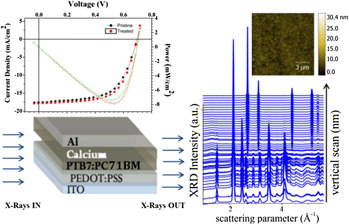Article contents
In situ space-resolved X-ray diffraction and time-resolved EDXD on efficient polymer-based photovoltaic devices: Microstructural properties and aging effects
Published online by Cambridge University Press: 24 January 2017
Abstract

Microstructural and morphological features of the layers forming integrated PTB7/PC71BM organic solar cells with Ca/Al cathode are studied. The effects of vacuum treatment on properties and durability were addressed using complementary approaches: time-resolved experiments revealing the structural evolution of the active layers under illumination were conducted combining the in situ energy dispersive X-ray diffraction (EDXD) technique with atomic force microscopy (AFM); space-resolved characterization of the integrated devices was possible via high resolution X-ray diffraction, using a nano-focused synchrotron radiation X-ray beam to discriminate the device components. Active layers surface morphology is stable under illumination and PC71BM structural properties remain unaltered. PTB7 undergoes crystallinity depletion, mainly at the active layer/cathode interface. This effect is actually inhibited in the device submitted to vacuum treatment, proving that this procedure induces stabilization at the cathode’s buried interface, as verified by fourier transform infrared (FTIR) spectroscopy. Importantly, the protective role of the vacuum treatment results in a significant photovoltaic durability enhancement.
Keywords
- Type
- Article
- Information
- Journal of Materials Research , Volume 32 , Issue 10: Focus Issue: Microstructural Characterization for Emerging Photovoltaic Materials , 26 May 2017 , pp. 1969 - 1981
- Copyright
- Copyright © Materials Research Society 2017
Footnotes
Contributing Editor: Moritz Riede
References
REFERENCES
- 1
- Cited by



